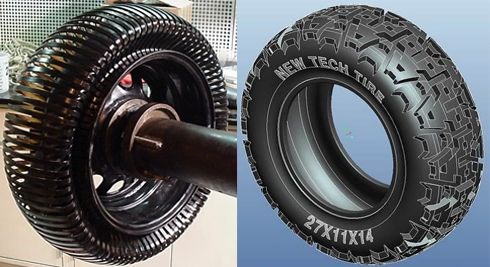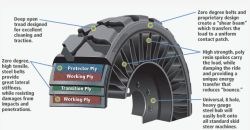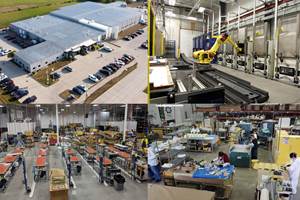Tires that never go flat
SciTech Industries and Rapid Composites develop high-volume production tires that use glass fiber/PET composite springs instead of innertubes and compressed air.

SciTech Industries and Rapid Composites have developed an airless tire using glass fiber/PET composite springs that replace innertubes and air while enabling unique performance advantages. SOURCE: SciTech Industries.
Non-pneumatic (“airless”) tires are not new. Michelin’s polyurethane (no fiber reinforcement that I can confirm) X TWEEL airless radial tires for construction, farm and lawn equipment are being produced at its new Piedmont, South Carolina factory. Bridgestone also has a model in development and Resilient Technologies is focusing its efforts on the military.

|

|

|
Michelin’s polyurethane and steel belted TWEEL airless tire (left),
Bridgestone’s development concept (center) and Resilient Technologies’ prototype for the military (right). SOURCE: http://www.michelintweel.com/whyTweel.html and http://www.bridgestonetire.com/tread-and-trend/tire-talk/airless-concept-tires and http://www.resilienttech.com.
SciTech Industries’ design is radically different, using glass fiber reinforced polyethylene terephthalate (PET) springs to support from inside the conventional rubber tread vs. shaped plastic spokes from the wheel’s center. It also fits a standard rim and does not make noise, even at elevated speeds. “It looks and even smells just like the tires on your car now,” says Morris Corn, president of SciTech Industries LLC, New Tech Tire LLC and Turf Tech Tire LLC (Boca Raton, FL, US), “but our manufacturing process requires only three operations vs. the 36 different steps required for today’s standard tires.” Corn adds that the SciTech airless tire costs no more to make than current tires, yet should boost fuel efficiency by at least 2% (inflation and shape does not change) and saves weight by eliminating the need for a spare.
SciTech’s tire could also help to eliminate all of those “thrown” treads on the highways, what truckers call “alligators”. Several reports show that almost 70% of these are caused by road hazards (impacts, punctures) and excessive heat, the latter caused mostly by underinflation, which causes heat to build up in the radial steel belts and subsequent delamination of the tread. SciTech’s composite-supported airless tire, however, can never be underinflated or overinflated. It also runs “cool”, preventing heat buildup, and can sustain multiple impacts from road hazards — even from ammunition rounds — while continuing safe operation. This is because out of an average 100 springs per tire (depending on tire size and loading), approximately nine are supporting load from the road at any given time. Thus, even the loss of several springs is not enough to cause failure. For trucking companies, this could save millions of dollars, tires being the second largest expense after drivers.

|

|
SciTech’s omega-shaped, glass fiber-reinforced PET springs (left) enable many of its performance advantages, as well as easy tailoring for a wide range of products such as bicycles, cars and lawnmowers, like the wide, more flexible Turf Tech tire shown here (right).
SOURCE: SciTech Industries.
The SciTech Industries non-pneumatic tire concept originated with an inventor, the one-time R&D manager for Taurus Hungarian Rubber Works in Budapest. He approached SciTech with the concept and the two companies worked to develop and test it, with SciTech eventually buying the patent and extending it worldwide. SciTech then assigned refinement of the springs to composites engineer Michael Moon (who also designed the composite tennis racket used by Serena Williams to win the 2005 U.S. Open).
The composite springs in SciTech’s airless tire were further developed by engineer Michael Moon, shown giving this presentation at a tire conference in Clemson, SC. SOURCE: Vimeo.com
The next step was to advance the manufacturing process. SciTech commissioned Rapid Composites (Myakka City, FL, US) to help design the equipment to make the tires on a commercial scale. “They are masters in development and have done a great job,” says Corn. “They have helped us do a lot in parallel instead of in series.”
The Skinny on Spring Supports
The omega-shaped composite spring supports are made using multiple spools of glass fiber, extruded with melted PET so that every filament is encapsulated. Extrusions then go into a heated mold which forms the springs. Formed springs and rubber for tread and sidewalls are robotically placed into the tire mold and, within minutes, a tire is completed. “Because our tires do not use a belt, we can produce them with a process quite similar to injection molding,” says Corn.
One of the key challenges was finding the right composite to allow infinite load cycling. “It needed to be as strong as steel,” says Corn, “but still flexible in order to match the ride of a pneumatic tire and yet resist heat build-up.” The springs can be tailored to meet a wide variety of demands — from thin wheels for bicycles, to wide wheels for lawn equipment, to 15-ft diameter tires for heavy equipment. The composites can use continuous E-glass or S-glass in a variety of deniers and may also exploit nanofibers or nanoclay — with a reported 40% boost in flexural strength. The design of the springs is also important, limiting deflection to meet these varied performance demands while preventing bending of the wheel rims in case of road hazards and holes.
Truly Disruptive
This is truly disruptive technology. “If this type of tire is adopted by the industry,” says Corn, “a lot of the current manufacturing equipment and infrastructure are no longer needed.” Fiber supplier Owens Corning (Toledo, OH, US) has even started to look at global glass fiber capacity.
Corn says the tire industry has made this type of change before, when it switched from bias belted tires — which it had used for 50 years — to radial tires in the 1950s and 60s. However, only Europe and Japan switched early on, with American tire companies refusing to retool and afraid of the 45% higher production cost and harder ride, even though the benefits of longer tread life, better steering, less rolling resistance and improved fuel economy were enough to win over overseas consumers. Goodrich eventually was forced out of the tire business over this, and in the end, it was the gas crisis, increased purchase of imports with radial tires and customer demand for better fuel mileage that finally forced the U.S. auto industry to adopt radial tires by 1983.
So what will the U.S. tire industry do this time? “We’ve already run tire trials in Europe,” says Corn, “and our pilot plant is now molding tires for American OEMs and tire producers to beta test.” In SciTech’s favor, its tire is actually less complex to produce and operate vs. current models, whereas the radial was more complex than bias belted tires. “Already, our small warehouse-sized pilot plant can make as many airless tires as a pneumatic tire factory spanning acres,” says Corn. The SciTech tire materials can also be recycled and made using a high percentage of recycled content, for a greener, more sustainable cradle-to-cradle cycle. Corn says the number of players already pursuing airless tires proves consumers are ready. “We’ve worked on this product and process for 12 years,” he adds. “We know we have a superior product, thanks to composites,” he adds. “We will find the right partner to offer the market what it wants.”
Additional benefits:
- At least 2% increase in fuel economy expected due to less sidewall flex and low rolling resistance.
- Tire shape and rolling resistance stays constant, no change due to inflation.
- Elimination of spare tire not only reduces weight but opens valuable packaging space for sensors, electronics, safety structure, etc.
Related Content
Optimizing a thermoplastic composite helicopter door hinge
9T Labs used Additive Fusion Technology to iterate CFRTP designs, fully exploit continuous fiber printing and outperform stainless steel and black metal designs in failure load and weight.
Read MoreJeep all-composite roof receivers achieve steel performance at low mass
Ultrashort carbon fiber/PPA replaces steel on rooftop brackets to hold Jeep soft tops, hardtops.
Read MoreCombining multifunctional thermoplastic composites, additive manufacturing for next-gen airframe structures
The DOMMINIO project combines AFP with 3D printed gyroid cores, embedded SHM sensors and smart materials for induction-driven disassembly of parts at end of life.
Read MorePlant tour: Sekisui Aerospace, Orange City, Iowa, Renton and Sumner, Wash., U.S.
Veteran composites sites use kaizen and innovation culture to expand thermoplastic serial production, 4.0 digitization and new technology for diversified new markets.
Read MoreRead Next
VIDEO: High-volume processing for fiberglass components
Cannon Ergos, a company specializing in high-ton presses and equipment for composites fabrication and plastics processing, displayed automotive and industrial components at CAMX 2024.
Read More“Structured air” TPS safeguards composite structures
Powered by an 85% air/15% pure polyimide aerogel, Blueshift’s novel material system protects structures during transient thermal events from -200°C to beyond 2400°C for rockets, battery boxes and more.
Read MoreAll-recycled, needle-punched nonwoven CFRP slashes carbon footprint of Formula 2 seat
Dallara and Tenowo collaborate to produce a race-ready Formula 2 seat using recycled carbon fiber, reducing CO2 emissions by 97.5% compared to virgin materials.
Read More






















